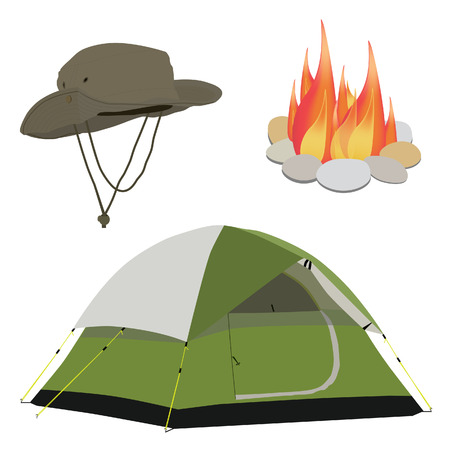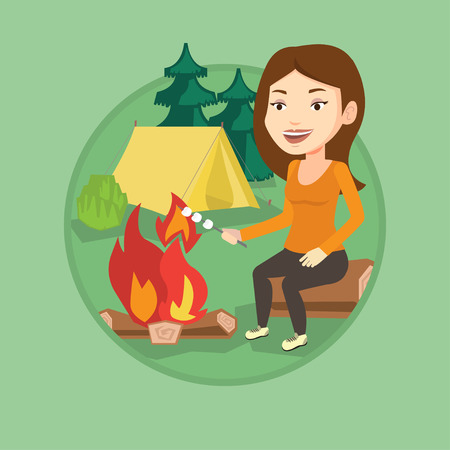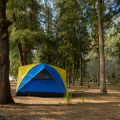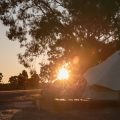1. What Is Dispersed Camping?
Dispersed camping is a type of camping that takes place outside of designated campgrounds, typically on public lands like National Forests and Bureau of Land Management (BLM) areas across the United States. Unlike traditional campgrounds, which offer amenities such as restrooms, fire rings, picnic tables, and marked campsites, dispersed camping means finding your own spot in nature—away from the crowds and facilities.
How Is Dispersed Camping Different From Campground Camping?
| Feature | Dispersed Camping | Campground Camping |
|---|---|---|
| Location | Undeveloped areas on public lands | Designated sites within managed campgrounds |
| Amenities | No amenities provided | May include toilets, water, fire pits, etc. |
| Reservations | First-come, first-served (no reservations) | Often requires reservations or permits |
| Crowds | Low; more solitude | Can be busy or fully booked |
| Cost | Usually free | Often includes nightly fees |
Why Choose Dispersed Camping?
Many outdoor lovers are drawn to dispersed camping for its simplicity and freedom. It allows you to connect with nature on a deeper level without the distractions of modern conveniences or large crowds. Its a great option if youre looking to:
- Escape busy campgrounds and enjoy peace and quiet
- Explore remote and scenic parts of National Forests
- Camp for free on public land (where allowed)
- Create your own unique camping experience away from others
This style of camping appeals especially to those who prefer a more rugged, self-reliant outdoor adventure. However, it also comes with extra responsibilities—like following Leave No Trace principles and being prepared with your own water, food, and sanitation supplies.
2. How to Find Legal Dispersed Camping Spots in National Forests
Dispersed camping is all about freedom and getting off the beaten path, but that doesn’t mean you can just set up camp anywhere in a national forest. To make sure youre camping legally and responsibly, its important to use the right tools and resources. Here’s how you can find legit dispersed camping spots across U.S. National Forests.
Use U.S. Forest Service Maps
The U.S. Forest Service (USFS) provides detailed maps for each national forest, often showing where dispersed camping is allowed. Look specifically for “Motor Vehicle Use Maps” (MVUMs), which indicate roads open to vehicles and areas where camping is permitted along those roads.
Where to Get USFS Maps:
- Online: Visit the official USFS Maps Website
- In Person: Stop by ranger stations or visitor centers in the area you plan to camp
- Mobile Apps: Download digital MVUMs through apps like Avenza Maps
Visit Local Ranger Stations
If youre already on the road or unsure about local regulations, ranger stations are your best resource. Rangers can tell you exactly where dispersed camping is allowed, provide paper maps, and alert you to any fire restrictions or closures.
What to Ask a Ranger:
- “Where is dispersed camping allowed in this forest?”
- “Are there any current fire bans or access restrictions?”
- “Can I get a Motor Vehicle Use Map for this area?”
Use Camping & Outdoor Apps
A variety of mobile apps have made finding legal dispersed campsites easier than ever. These apps include user-submitted locations, reviews, GPS coordinates, and notes about road conditions or cell service.
Popular Apps for Finding Dispersed Campsites:
| App Name | Main Features | Cost |
|---|---|---|
| The Dyrt | User reviews, offline maps, filter for free sites | Free with optional Pro version |
| iOverlander | User-submitted dispersed campsites and GPS info | Free |
| CampsitePhotos.com | Campsite images and reviews, some dispersed sites listed | Free |
| Avenza Maps | Makes USFS MVUMs GPS-enabled on your phone | Free with paid maps available |
| Gaia GPS | Diverse map layers including public land boundaries and MVUMs | Free with optional Premium subscription |
Telltale Signs Youre in a Legal Spot
If youre out exploring without cell signal or maps loaded ahead of time, here are a few general signs youre likely in a legal dispersed campsite:
- You’re on federal land (not private property)
- You’re at least 100–200 feet from water sources like lakes and streams (this varies by forest)
- You see existing fire rings or clearings used previously by campers
- You’re not blocking roads or trailheads and are parked off the main road within designated zones if required by that forests rules
A Quick Tip:
If youre planning a trip during peak season, try scouting potential camp areas using satellite view on Google Maps before heading out. Mark GPS coordinates so you have options lined up even without service.
The key to successful dispersed camping is preparation—knowing where to go, what’s allowed, and having the right tools handy makes all the difference.

3. Rules, Regulations, and Best Practices
Before heading out for dispersed camping in a U.S. national forest, it’s important to know the basic rules and follow best practices. These guidelines help protect the environment and ensure everyone can enjoy the great outdoors safely and responsibly.
Leave No Trace Principles
The Leave No Trace (LNT) principles are the gold standard for outdoor ethics. They help minimize human impact on nature. Heres a quick overview:
| Principle | Description |
|---|---|
| 1. Plan Ahead and Prepare | Research the area, weather, and regulations before you go. |
| 2. Travel and Camp on Durable Surfaces | Use existing campsites or areas without vegetation to avoid damaging plants. |
| 3. Dispose of Waste Properly | Pack out all trash, leftover food, and litter. Bury human waste 6-8 inches deep at least 200 feet from water. |
| 4. Leave What You Find | Avoid disturbing natural or cultural features like rocks, plants, or artifacts. |
| 5. Minimize Campfire Impact | Use a camp stove when possible. If fires are allowed, use existing fire rings and keep fires small. |
| 6. Respect Wildlife | Observe animals from a distance and never feed them. |
| 7. Be Considerate of Other Visitors | Keep noise levels down and respect others space and experience. |
Fire Restrictions
Wildfires are a serious risk in many parts of the U.S., especially during dry seasons. Fire restrictions vary by region and time of year. Always check with the local ranger district before building any fire. Some areas may only allow camp stoves or ban all open flames altogether.
Tips for Safe Fires (When Allowed)
- Use existing fire rings if available.
- Never leave a fire unattended.
- Douse the fire completely with water before leaving — stir ashes until cold to the touch.
Campsite Limits and Duration
You can’t just camp anywhere forever — each national forest has rules about how long you can stay in one spot:
| Campsite Rule | Description |
|---|---|
| Campsite Distance | Your site must be at least 100–200 feet away from lakes, rivers, trails, and roads (varies by forest). |
| Stay Limit | You can typically stay up to 14 consecutive days in one location within a 30-day period per ranger district. |
No Camping Zones & Permits
Certain areas may prohibit dispersed camping entirely due to sensitive ecosystems or high traffic. Popular spots like near trailheads or scenic landmarks often have restrictions or require permits even for dispersed camping. Always double-check with the local Forest Service office or website for specific regulations where you plan to go.
Packing Smart: Required & Recommended Gear
- A shovel — useful for burying waste or extinguishing fires.
- A bear-proof food container — especially important in bear country.
- A map and compass or GPS — cell service is often unavailable in remote areas.
The more prepared you are, the better your trip will be — both for your safety and for preserving these beautiful public lands for future campers to enjoy.
4. Essential Gear for Off-Grid Camping
When youre heading into the backcountry for dispersed camping in a U.S. National Forest, being fully self-sufficient is key. Since there are no amenities like restrooms, potable water, or trash services, having the right gear can make your experience safer and more enjoyable. Heres a checklist of must-have items to pack for your off-grid adventure.
Water Filtration and Storage
Clean drinking water is your top priority. Streams and lakes might look clear but can carry harmful bacteria or parasites. Always bring a reliable water filtration system along with enough containers to store filtered water.
| Item | Description |
|---|---|
| Water Filter or Purifier | Pump filters, gravity systems, or UV purifiers are great options depending on your preference and group size. |
| Collapsible Water Containers | Lightweight and easy to pack when empty; ideal for storing clean water at camp. |
| Hydration Bladders or Bottles | For daily use on hikes or around camp. |
Portable Toilets and Hygiene Supplies
Leave No Trace principles mean you’re responsible for all waste—including human waste. If digging a cathole isn’t possible or permitted, a portable toilet is a must.
| Item | Description |
|---|---|
| Portable Toilet System | Includes waste bags and containers—look for systems that meet Leave No Trace standards. |
| Trowel/Shovel | If allowed, use this to dig a cathole 6–8 inches deep and 200 feet away from any water source. |
| Biodegradable Toilet Paper & Hand Sanitizer | Essential for hygiene—pack it out in a sealed bag if not buried properly. |
Bear-Proof Food Storage
In many national forests, especially in bear country, proper food storage isnt just smart—its required by law. Always secure food and scented items in approved containers.
| Item | Description |
|---|---|
| Bear Canister or Bear Bag (e.g., Ursack) | Bears have an incredible sense of smell—store all food, toiletries, and trash in these containers away from your sleeping area. |
| Odor-Proof Bags | Add an extra layer of scent protection inside your bear canister or bag. |
| Rope & Carabiners (for bear hangs) | If using the hang method, make sure you know how to tie proper knots and set up a safe hang 10-15 feet off the ground. |
Shelter and Sleep System
Your tent, sleeping bag, and pad should be suited to the region’s climate. Nights in the forest can get cold—even in summer—so plan accordingly.
Shelter Checklist:
- Tent or hammock with bug netting and rainfly
- Ground tarp or footprint to protect your tent floor
- Stakes and guylines to secure shelter in windy conditions
Sleep System:
- Sleeping bag rated for expected temperatures
- Sleeping pad or inflatable mattress for insulation and comfort
- Pillow or stuff sack filled with clothes as a pillow alternative
Cooking Equipment and Fire Safety Gear
A compact cooking setup is essential since open fires may be restricted due to fire danger. Always check local fire regulations before lighting any flame.
| Item | Description |
|---|---|
| Backpacking Stove & Fuel Canisters | A lightweight stove lets you cook quickly without needing firewood. |
| Pots/Pans & Utensils | Nesting cookware saves space; don’t forget a lighter or waterproof matches! |
| Fire Extinguisher or Shovel & Water Bucket (if fires are allowed) | Makeshift tools to fully extinguish campfires where permitted. |
| Biodegradable Soap & Sponge | Clean dishes at least 200 feet from water sources; strain food particles from graywater before disposal. |
Navigation and Emergency Gear
You cant count on cell service in remote areas. A good map and compass—or GPS device—can literally be lifesaving. Also pack emergency essentials even if youre just planning an overnight trip.
- Topographic maps of the area + compass (and knowledge of how to use them)
- GPS device or satellite communicator (like Garmin InReach)
- First aid kit with tweezers, antiseptic wipes, bandages, etc.
- Multi-tool or knife for repairs and general use
- Headlamp with extra batteries (hands-free light source is crucial)
- Sunscreen, insect repellent, sunglasses, hat for sun protection
- Duct tape & repair patches for fixing gear on the fly
- An extra day’s worth of food—just in case!
The key to successful dispersed camping is preparation. With this gear checklist tailored to the remote nature of National Forest camping across the U.S., youll be ready to enjoy nature safely while minimizing your impact on the environment.
5. Safety Tips and Wilderness Preparedness
Dispersed camping in national forests offers a true escape into nature, but it also means being far from help and modern conveniences. Staying safe while off the grid requires preparation, awareness, and the right gear. Heres how to be ready for anything when youre deep in the woods.
Navigation: Know Where You Are
Cell service is often unreliable or completely unavailable in remote areas. Don’t rely solely on your phones GPS. Instead, bring multiple navigation tools and know how to use them:
| Navigation Tool | Why Its Important |
|---|---|
| Paper Maps (USFS Topographic Maps) | Don’t require batteries or signal; show forest roads and trails. |
| Compass | Essential for orienting yourself with a map. |
| GPS Device (Handheld) | More reliable than phones in remote locations. |
Wildlife Encounters: Be Alert and Respectful
You’re entering their territory, so it’s important to respect wildlife. Most animals will avoid humans if left undisturbed, but accidents happen when we leave food out or get too close.
Tips to Prevent Dangerous Wildlife Encounters:
- Store food properly: Use bear-proof containers or hang food at least 10 feet off the ground and 4 feet away from tree trunks.
- Keep a clean camp: Pack out all trash and never leave food scraps behind.
- Make noise while hiking: This helps avoid surprising animals like bears or mountain lions.
- Carry bear spray: Know how to use it and keep it accessible.
First Aid Readiness: Be Your Own First Responder
A well-stocked first aid kit is essential for any dispersed camping trip. You won’t have immediate access to emergency services, so you need to handle minor injuries yourself.
Must-Have Items in Your Camping First Aid Kit:
- Antiseptic wipes and antibiotic ointment
- Bandaids, gauze pads, and medical tape
- Tweezers (for splinters or ticks)
- Pain relievers like ibuprofen or acetaminophen
- A digital thermometer
- An emergency blanket
- A guidebook or checklist on wilderness first aid techniques
No Cell Service? Plan for Emergencies Anyway
If something goes wrong, you can’t always count on calling for help. That’s why it’s crucial to have an emergency plan before heading out.
Key Emergency Preparedness Tips:
- Tell someone your plans: Share your exact location, route, and expected return time with a friend or family member.
- Bring a personal locator beacon (PLB) or satellite messenger: These devices can send SOS messages even without cell service.
- Create a simple signal system: Three whistles or three flashes of a light means “help.” Know how to communicate distress without words.
- Stay put if lost: Moving around may make it harder for rescuers to find you. Use your gear to stay warm and visible.
The more prepared you are, the more enjoyable your dispersed camping experience will be. A little planning goes a long way in keeping you safe while exploring Americas incredible national forests.
6. Top National Forests for Dispersed Camping in the U.S.
Looking for the best places to experience dispersed camping? The U.S. is full of incredible national forests that offer remote beauty, easy access, and a chance to truly connect with nature. Heres a curated list of top national forests across different regions to help you plan your next adventure.
Western U.S.
The western states are known for vast public lands and dramatic landscapes—perfect for dispersed camping.
| National Forest | Location | Highlights | Tips |
|---|---|---|---|
| Kaibab National Forest | Arizona | Grand Canyon views, high elevation pine forests | Camp near the North Rim for cooler temps and fewer crowds |
| Sierra National Forest | California | Access to Yosemite, lakes, and alpine meadows | Check snow conditions in early summer; bear-proof your food |
| Deschutes National Forest | Oregon | Lava fields, mountain peaks, and rivers | Avoid fire season by checking restrictions before you go |
Rocky Mountains Region
This area offers rugged terrain, high altitudes, and some of the most scenic drives in the country.
| National Forest | Location | Highlights | Tips |
|---|---|---|---|
| Pike-San Isabel National Forests | Colorado | Tall peaks, alpine lakes, off-road trails | Campsites fill fast in summer—go midweek if possible |
| Custer Gallatin National Forest | Montana/Wyoming | Close to Yellowstone, wildlife viewing opportunities | Bring bear spray and store food properly—grizzlies roam here! |
Southeast U.S.
If youre looking for lush forests and mild winters, these southern spots are worth checking out.
| National Forest | Location | Highlights | Tips |
|---|---|---|---|
| Nantahala National Forest | North Carolina | Misty mountains, waterfalls, Appalachian Trail access | Bugs can be intense in summer—bring repellent! |
| Cherokee National Forest | Tennessee | Riverside camping, scenic byways, hiking trails galore | Avoid popular sites during fall leaf season unless you book early or go midweek |
Northern States & Midwest
This region offers peaceful woodlands and plenty of lakeside camp spots perfect for canoeing and fishing.
| National Forest | Location | Highlights | Tips |
|---|---|---|---|
| Chequamegon-Nicolet National Forest | Wisconsin | Lakes, rivers, dense hardwood forests |
Mosquitoes can be thick in early summer—bring netting! |
| Superior National Forest (including Boundary Waters) | Minnesota |
Canoe routes, boreal forest scenery |
You’ll need a permit if entering Boundary Waters Canoe Area Wilderness (BWCAW) |
A Few More Tips When Choosing Your Spot:
- Call ahead: Contact local ranger stations for road conditions and current regulations.
- Avoid overused areas: Look for less-trafficked roads or pull-offs to minimize impact.
- Packing smart: Bring everything you need—including water—and follow Leave No Trace principles.
No matter where you go, America’s national forests offer something special for every type of camper. Whether youre chasing mountain sunsets or paddling a quiet lake at dawn, dispersed camping gives you front-row access to the wild side of the country.


